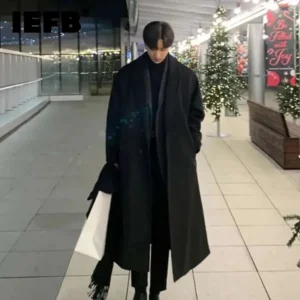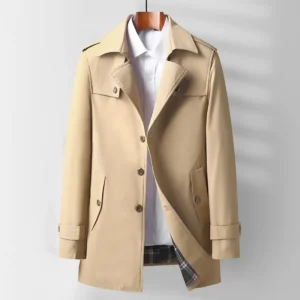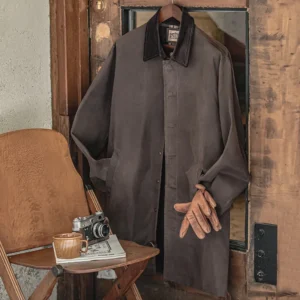1. Introduction: The Classic Elegance of Herringbone Pattern in Men’s Coats
The herringbone pattern stands as one of menswear’s most distinguished and enduring design elements. This distinctive broken twill weave creates a visual texture that resembles the skeleton of a herring fish—hence its evocative name. Characterized by a series of parallel lines that create a zigzag or V-shaped pattern, herringbone offers a sophisticated aesthetic that has adorned quality outerwear for generations.
What makes herringbone particularly remarkable is its ability to add visual interest and texture to a garment without appearing flashy or ostentatious. The pattern creates depth and dimension, elevating even the simplest coat silhouette to something more refined and considered. Men’s outerwear particularly benefits from this pattern, as it introduces character while maintaining versatility.
Finding the perfect coat involves numerous considerations, including the choosing right coat length to complement your physique and style preferences. Throughout this guide, we’ll explore the technical aspects of herringbone, its rich history, ideal materials, styling techniques, and why this timeless pattern continues to define sophisticated men’s outerwear.
2. What Defines a Herringbone Pattern: The Technical Aspects
Herringbone derives its distinctive appearance from what textile experts call a “broken twill weave.” Unlike a standard twill, which creates diagonal lines moving consistently in one direction, herringbone is characterized by columns of slanted parallel lines that alternate in direction. This creates the signature V-shaped or zigzag pattern that resembles the skeleton of a herring fish.
The technical characteristics that define true herringbone include:
- Alternating diagonal ribs that create a distinctive point where the direction reverses
- A broken zigzag appearance rather than a continuous wave
- Columns of opposing slant that create visual movement across the fabric
- Typically woven on a 2×2 or 4×4 twill base structure
The scale of herringbone can vary considerably, from fine patterns where the zigzag is barely discernible from a distance to bold, large-scale herringbones that make a more dramatic statement. This variation in scale affects the visual impact and formality of the pattern.
Beyond aesthetics, the technical construction of herringbone contributes to the fabric’s durability. The interlocking nature of the weave creates a tight, sturdy textile that holds its shape well and resists wear—one reason why many men’s coat length guide recommendations feature herringbone as an ideal pattern for investment pieces.
3. The Origins and History of Herringbone Pattern
The herringbone pattern boasts an impressively ancient lineage. Its earliest documented use dates back to the Roman Empire, where it appeared not in textiles but in road paving systems. Roman engineers used a construction technique called “Opus Spicatum” (meaning “spiked work”), arranging bricks in a herringbone pattern to create roads with superior structural integrity.
Evidence of herringbone-woven textiles appears in ancient Egyptian cloths, Irish tweed artifacts, and across numerous early European civilizations. The pattern transcended its utilitarian origins to become a decorative element, valued for both its structural benefits and visual appeal.
By the Middle Ages, herringbone had established itself within European textile traditions, particularly in wool weaving. The pattern’s association with quality fabrics began during this era, as creating the pattern required more advanced weaving skills.
The British tailoring tradition embraced herringbone during the 18th and 19th centuries, particularly in the production of tweed and woolen outerwear. Country estates often featured their own distinctive herringbone tweeds, which were worn for outdoor activities like hunting and later adapted for urban wear.
Through changing fashion trends and evolving garment construction techniques, herringbone maintained its place in quality menswear. Its subtle sophistication and the enduring symbolism of herringbone pattern have allowed it to remain relevant across generations, representing timeless style rather than fleeting fashion.
4. Materials That Showcase Herringbone Best
Different materials can dramatically alter the appearance and performance of herringbone patterns, each bringing unique characteristics to this classic weave.
Wool Variations
Wool remains the quintessential material for herringbone coats, offering natural insulation, moisture-wicking properties, and excellent drape. Different wool types provide varying effects:
- Worsted wool: Creates a smoother, more defined herringbone pattern with a sleeker finish, ideal for more formal overcoats
- Lambswool: Offers a softer texture with a slightly fuzzier appearance that softens the pattern’s definition
- Merino: Provides exceptional softness and fine detail, allowing for more intricate herringbone patterns
Tweed Variants
Tweed herringbone represents perhaps the most iconic application of the pattern, with several regional variations:
– Harris Tweed: Hand-woven with distinctive color flecks that add depth to the herringbone pattern
– Donegal Tweed: Features colorful slubs throughout, creating visual interest against the herringbone background
– Shetland Tweed: Typically features softer textures and more muted colorways
Luxury Materials
For premium herringbone coats, several luxury materials stand out:
– Cashmere: Creates an incredibly soft, lightweight herringbone with unmatched drape and warmth
– Cashmere-wool blends: Offer practical luxury, combining cashmere’s softness with wool’s durability
– Camel hair: Provides a distinctive golden hue with excellent insulation properties
Selecting the appropriate material weight is crucial depending on your climate needs. Understanding how your height affects proper coat proportions makes finding the perfect coat length for height essential for a flattering fit regardless of material choice.
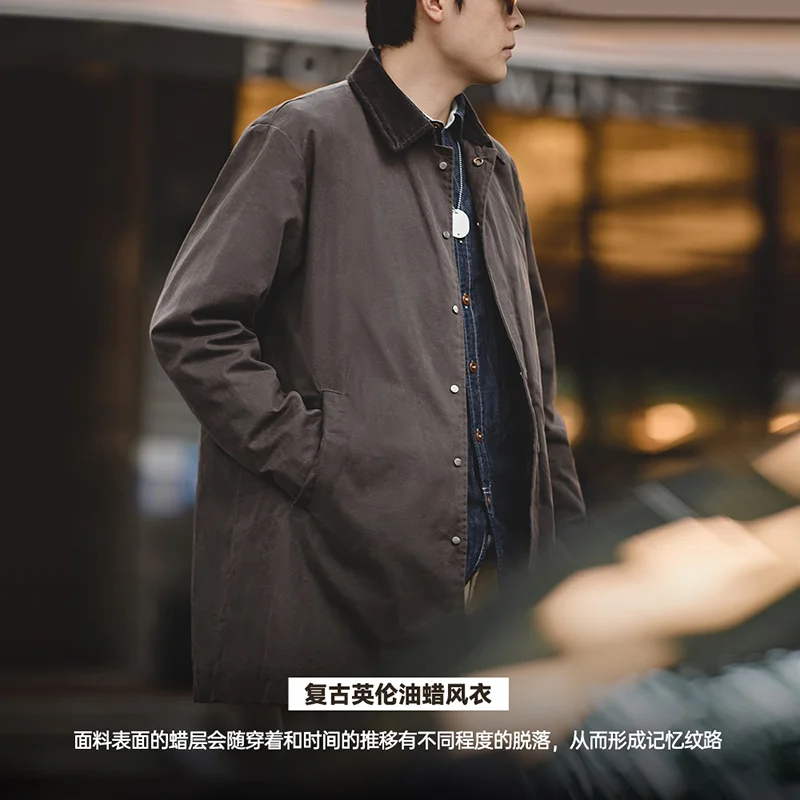
5. Distinguishing Herringbone from Similar Patterns
Herringbone is often confused with several similar patterns, but knowing the key differences helps in appreciating its unique characteristics:
Herringbone vs. Chevron
While both patterns feature a zigzag appearance, herringbone is distinguished by its “broken” zigzag. In herringbone, the diagonal lines reverse direction at each column, creating distinct points. Chevron, conversely, presents a continuous zigzag where the diagonal lines meet perfectly to form unbroken V-shapes.
Herringbone vs. Houndstooth
Houndstooth is a distinct check pattern characterized by broken checks that resemble four-pointed stars or abstract dog teeth. Unlike herringbone’s continuous zigzag flow, houndstooth creates a more punctuated, checkered appearance with greater contrast between its elements.
Herringbone vs. Plain Twill
Plain twill creates diagonal lines that all run in the same direction, producing a unified diagonal texture. Herringbone differs fundamentally by reversing the diagonal direction at regular intervals to create its signature V-pattern.
Herringbone vs. Barleycorn
Barleycorn features small, raised tufts arranged in a diagonal pattern that resembles grains of barley. It creates a more three-dimensional texture compared to herringbone’s flatter, more geometric appearance.
Quality herringbone patterns will show consistency in the reversal points and maintain even spacing between the zigzags. When comparing different coat patterns, the distinctions between herringbone plaid coat patterns can help inform your selection for specific style preferences and occasions.
6. The Versatility of Herringbone Coat Styles
Herringbone’s adaptability allows it to enhance virtually every coat style in men’s outerwear, from the most formal to casual options:
Overcoats and Topcoats
The full-length herringbone overcoat represents perhaps the most classic application of the pattern. These knee-length or longer garments present an expansive canvas for the pattern, creating a sophisticated silhouette suitable for formal occasions and business wear. Typically crafted with a cleaner pattern definition, these coats often feature traditional details like notch lapels and flap pockets.
Car Coats and Pea Coats
Mid-length options like car coats and pea coats benefit from herringbone’s ability to add visual interest to their more compact forms. The herringbone pattern works particularly well with the structured nature of these garments, often appearing in medium-scale patterns that balance the coat’s proportions. These versatile pieces bridge the gap between formal and casual wear.
Blazers and Sport Coats
Shorter herringbone options provide excellent layering pieces for cooler weather. The pattern adds sophistication to these more casual silhouettes, making them ideal for smart-casual settings. Herringbone blazers often feature a softer construction and may incorporate more colorful weaves than their longer counterparts.
The pattern scale typically correlates with the formality of the garment—finer herringbone patterns generally appear in more formal coats, while larger, more pronounced patterns often feature in casual pieces. For those seeking classic sophistication, our men’s herringbone coat collection offers options spanning these various styles.
7. Styling a Herringbone Coat: From Formal to Casual
The versatility of herringbone coats allows them to transition seamlessly between different dress codes and occasions with the right styling approach.
Formal Styling
For business and formal occasions, herringbone coats create a refined appearance:
– Pair a fine-patterned herringbone overcoat with a dark suit in navy or charcoal
– Complement with solid-colored accessories like a cashmere scarf in burgundy or navy
– Choose leather gloves and formal footwear in black or dark brown
– Keep accessories minimal and sophisticated to maintain the coat’s elegant presence
Business Casual Approaches
Herringbone effortlessly elevates business casual ensembles:
– Layer a medium-weight herringbone coat over a merino sweater and button-down shirt
– Combine with wool trousers or premium dark denim
– Add textural contrast with knitted ties or patterned scarves
– Consider brown leather accessories for a softer, more approachable look
Casual Styling
Even in relaxed settings, herringbone adds refinement without appearing overdressed:
– Wear a more textured herringbone coat with jeans and a chunky sweater
– Incorporate casual elements like suede boots or leather sneakers
– Layer with more casual pieces like chambray shirts or lightweight turtlenecks
– Consider more colorful or larger-scale herringbone patterns for distinctly casual settings
When mixing patterns, remember that herringbone works best with solids or subtly patterned pieces. The pattern’s versatility makes men’s wool overcoat styles in herringbone particularly valuable for wardrobes spanning multiple dress codes.
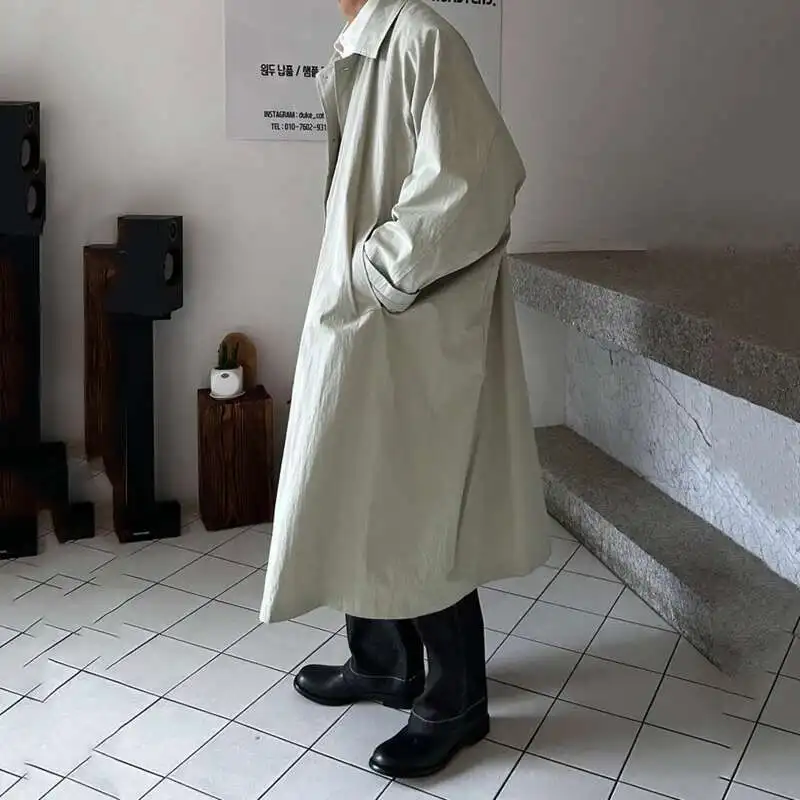
8. Identifying Quality in Herringbone Coats
When investing in a herringbone coat, several key indicators can help you identify superior quality and craftsmanship:
Pattern Execution
- Look for consistent pattern alignment across seams, particularly at the shoulders, sleeves, and center back
- Check for symmetrical pattern placement that follows the garment’s lines
- Ensure the pattern scale complements the coat’s proportions and style
Construction Elements
- Examine the lapels for proper rolling and clean edges without bubbling
- Check that the collar sits flush against the neck without gapping
- Inspect buttonholes for clean, tight stitching with no loose threads
- Full or half-canvas construction (rather than fused) indicates superior quality
Material Assessment
- Fabric should feel substantial but drape well, without appearing stiff
- Higher wool counts (Super 120s and above) indicate finer fibers
- Examine fabric against light to assess density and opacity
- Test recovery by gently pinching the fabric—quality wool springs back quickly
Finishing Details
- Look for horn or quality corozo buttons securely attached with shank construction
- Check lining material quality—Bemberg or silk linings indicate premium construction
- Examine pocket construction for reinforcement and clean finishing
Quality herringbone patterns maintain consistency throughout the garment, with no distortions at seams or edges. These investment pieces, like those found in our men’s tweed coat collection, offer superior durability and timeless appeal that justify their higher price point.
9. Maintaining the Beauty of Your Herringbone Coat
Proper maintenance ensures your herringbone coat remains beautiful for years to come:
Cleaning Recommendations
- Brush your coat regularly with a clothes brush to remove surface dirt and debris
- Spot clean minor stains promptly using a damp cloth and mild soap
- Professional dry cleaning only when necessary (typically once per season)
- Allow 24 hours of rest between wearings to allow the wool to recover its shape
Storage Practices
- Use wide, wooden hangers that support the shoulders properly
- Button the coat when hanging to maintain proper shape
- Store in breathable garment bags, avoiding plastic which can trap moisture
- Add cedar blocks to deter moths without damaging fibers
Seasonal Care
- Before storage, ensure the coat is completely clean and dry
- Brush thoroughly and air out the coat before seasonal storage
- Avoid storing in attics, basements, or areas with humidity fluctuations
- Inspect periodically during off-season storage for any issues
Minor Repairs
- Address loose buttons immediately before they become lost
- Have small tears or worn areas repaired promptly by a skilled tailor
- Consider preventative reinforcement of high-wear areas like cuffs and pockets
These care practices help preserve the integrity of the fabric and construction, ensuring your investment piece from our men’s overcoats collection maintains its distinguished appearance through years of wear.
10. Why Herringbone Remains a Cornerstone of Men’s Outerwear
Herringbone’s enduring place in men’s outerwear stems from a perfect balance of practical benefits and aesthetic appeal that transcends fashion cycles.
The pattern’s visual sophistication offers depth and character without being tied to specific trends. This quality allows herringbone coats to remain relevant across decades, making them true investment pieces rather than seasonal purchases. The subtle texture creates visual interest while maintaining versatility across different settings and outfit combinations.
From a practical perspective, the herringbone weave provides superior durability compared to many other patterns. The interlocking structure distributes wear more evenly across the fabric, allowing quality coats to maintain their appearance even after years of regular use. This longevity perfectly aligns with the modern emphasis on sustainable, long-lasting garments.
Perhaps most significantly, herringbone succeeds in bridging formal and casual contexts in a way few other patterns can. Understanding is herringbone formal or casual helps appreciate how this versatile pattern can elevate casual attire or soften formal looks, making it exceptionally adaptable to contemporary wardrobes that must span multiple dress codes.
With its rich heritage, technical quality, and enduring style, herringbone represents not merely a pattern but a statement of refined taste that continues to define distinguished men’s outerwear.
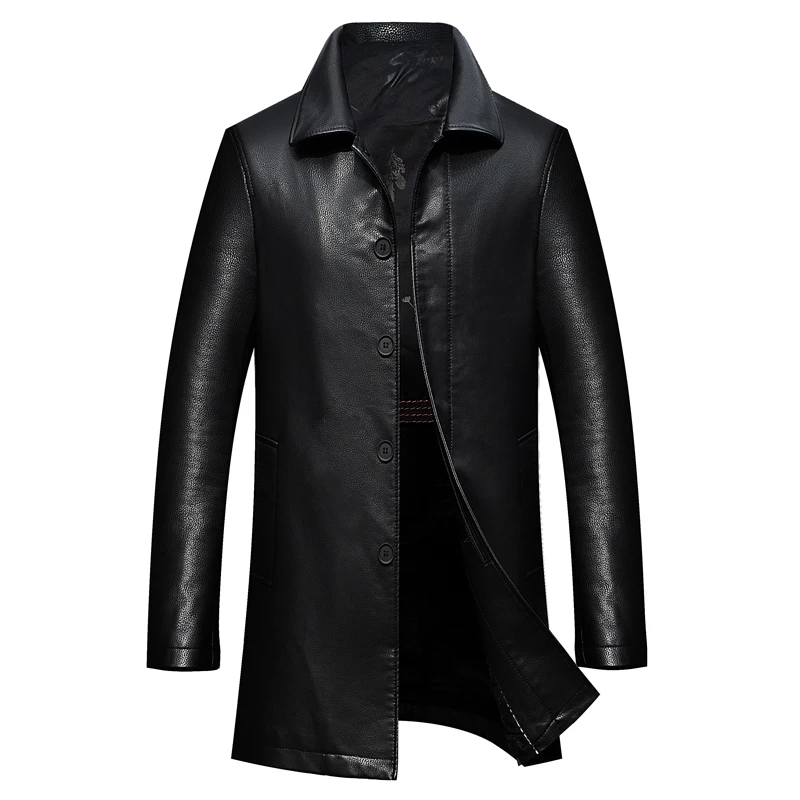
Mens Cashmere Overcoat, Mens Hooded Winter Coat, Mens Wool Blend Coat
Price range: $128.72 through $139.68 Select options This product has multiple variants. The options may be chosen on the product pageMens Black Overcoat, Mens Black Wool Coat, Mens Wool Overcoat
$339.18 Select options This product has multiple variants. The options may be chosen on the product pageMens Grey Overcoat, Mens Wool Blend Coat, Mens Wool Overcoat
$201.28 Select options This product has multiple variants. The options may be chosen on the product pageMens Herringbone Coat, Mens Long Overcoat, Mens Wool Overcoat
Price range: $197.16 through $203.69 Select options This product has multiple variants. The options may be chosen on the product pageMens Long Overcoat, Mens Topcoats
Price range: $189.40 through $196.88 Select options This product has multiple variants. The options may be chosen on the product pageMens Long Overcoat, Mens Tweed Coat
Price range: $397.49 through $409.96 Select options This product has multiple variants. The options may be chosen on the product page
11. Beyond Outerwear: Other Applications of Herringbone Pattern
While herringbone achieves its most iconic expression in outerwear, the pattern’s versatility extends to numerous other applications both within menswear and beyond.
In men’s clothing, herringbone appears frequently in suiting, particularly in lighter weight wools for year-round wear. The pattern adds subtle texture to trousers, waistcoats, and accessories like ties and pocket squares. These complementary pieces allow for coordinated looks without appearing overly matched when paired with herringbone outerwear.
The home environment embraces herringbone in various forms. Traditional wood flooring often features this pattern for both its visual appeal and structural stability. Upholstery fabrics, throw blankets, and decorative pillows in herringbone weaves introduce sophistication and texture to interior spaces without overwhelming other design elements.
Contemporary designers have expanded herringbone into unexpected territories, including leather goods, technology accessories, and modern casual wear. These applications demonstrate how traditional patterns can be refreshed through material innovation and scale manipulation.
For those interested in extending their appreciation of this classic pattern beyond their outerwear collection, our men’s dress coat selection showcases how herringbone can enhance various formal and semi-formal occasions with its timeless character.





